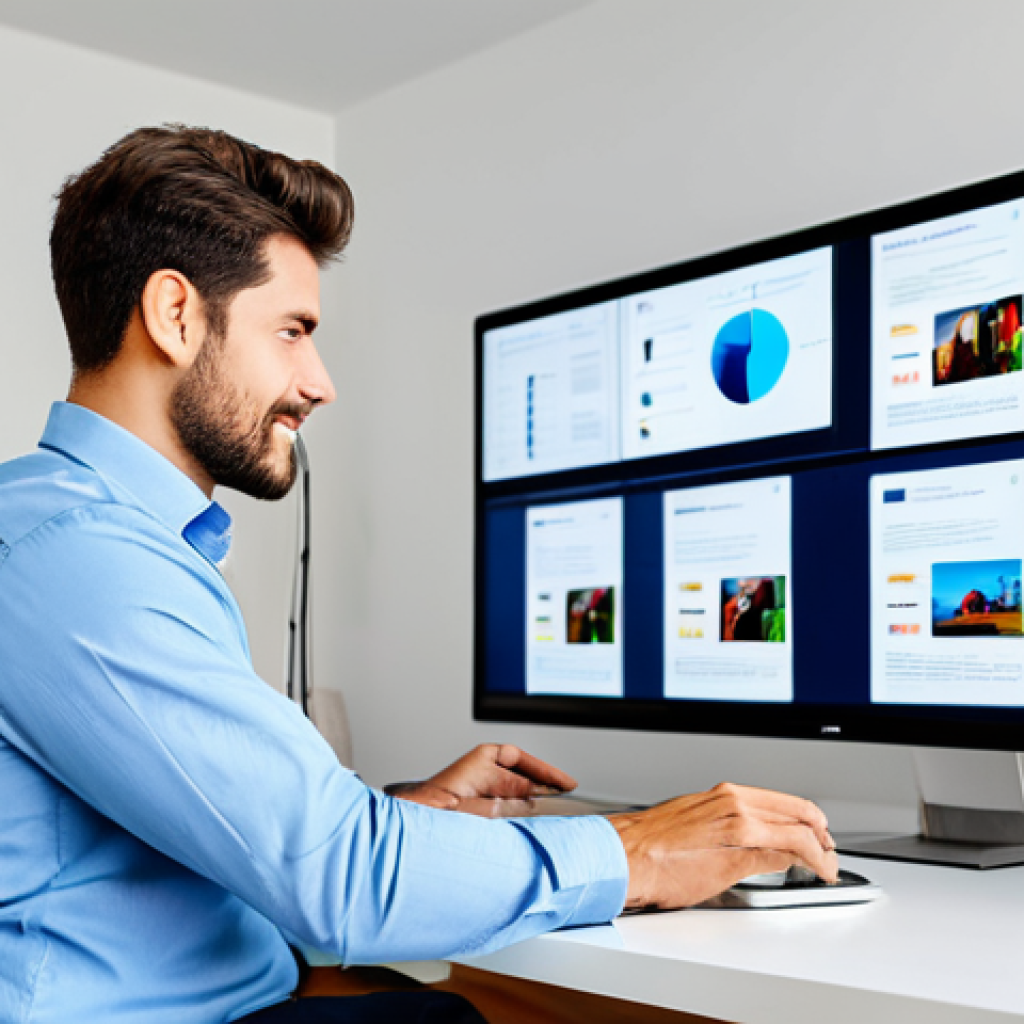Remember the days of flipping through TV channels aimlessly or waiting for the morning paper? It feels almost quaint now, doesn’t it? The media landscape has been utterly transformed, not just by streaming services but by a relentless digital current that’s reshaping how we consume, create, and interact with information.
From niche podcasts to global blockbusters delivered instantly, our screens have become portals to an ever-expanding universe of content. This isn’t just an evolution; it’s a revolution, fundamentally altering industries and daily lives.
Let’s explore it precisely. When I first dabbled with online content back in the early 2000s, I honestly couldn’t have imagined the sheer speed at which everything would change.
What began as simple websites has blossomed into an intricate ecosystem of streaming giants, personalized news feeds driven by sophisticated algorithms, and a vibrant creator economy that puts individual voices center stage.
I mean, who would’ve thought we’d be subscribing directly to our favorite podcaster for exclusive content, or seeing AI-generated art making headlines that you can’t even tell isn’t human-made?
It’s truly mind-boggling how far we’ve come. The flip side, though, is the overwhelming flood of information; frankly, it’s exhausting trying to filter through the noise and discern what’s genuinely trustworthy amidst the deepfakes and clickbait.
From my own experience navigating this digital sea, it feels like we’re constantly on alert, sifting through an endless feed. Looking ahead, what’s truly fascinating is how quickly AI is pushing the boundaries, not just in content *creation* but in hyper-personalizing our media experience to an almost unnerving degree.
Imagine an algorithm that knows your exact mood and delivers the perfect story or song, tailor-made just for you. We’re already seeing glimpses of this with adaptive advertising and customized playlists.
Beyond that, I predict a fascinating push towards truly interactive, perhaps even immersive, narratives where you’re not just a viewer but a participant – think AR/VR integrated seamlessly into your daily news or entertainment.
The big question, of course, revolves around ethics and ownership; will decentralized platforms using blockchain technology truly give creators more control and foster fairer monetization, or will the tech giants simply consolidate more power?
It’s a high-stakes game, and honestly, the implications for privacy and public discourse are massive. We’re heading into uncharted territory, and it’s exhilarating yet slightly terrifying all at once.
What a ride it’s going to be!
The Seismic Shift in How We Consume Information

What a whirlwind it’s been, hasn’t it? Just thinking back to how we used to get our news or entertainment feels like a scene from a black-and-white movie.
My own journey through this digital evolution started with dial-up modems and grainy streaming, and honestly, the transformation has been nothing short of breathtaking.
It’s not just about speed anymore; it’s about an utterly fundamental change in our relationship with information. We’ve moved from being passive recipients to active participants, often simultaneously creators and consumers.
This shift has democratized media in ways we never thought possible, putting powerful tools into the hands of individuals and radically changing the gatekeepers of content.
Gone are the days when a few major networks dictated what we watched or read; now, a single viral tweet or an independent podcast can reshape public discourse or launch a global phenomenon.
It’s liberating, yes, but also incredibly complex, requiring a constant re-evaluation of how we discover, trust, and interact with the stories and insights that shape our understanding of the world.
1. From Broadcast to Personalized Feeds
I remember the palpable anticipation of appointment viewing, gathering around the TV for a specific show at a specific time. That’s largely a relic of the past for many of us, myself included.
Now, our media consumption is meticulously tailored, driven by sophisticated algorithms that predict our preferences with unnerving accuracy. Think about your Netflix recommendations or your Spotify Discover Weekly playlist – it’s almost like having a personal curator who intimately understands your tastes, often better than you do yourself.
While incredibly convenient, this personalization also introduces the concept of filter bubbles, where we’re increasingly exposed only to information that confirms our existing biases.
It’s a double-edged sword: unparalleled access to niche interests versus the potential for a narrowed worldview. Personally, I’ve had to make a conscious effort to break out of these bubbles, actively seeking out diverse perspectives that the algorithms might not naturally surface for me.
2. The Explosion of On-Demand Culture
The sheer convenience of on-demand content is something I truly appreciate, and it’s a massive driver of current media habits. From binge-watching entire seasons of a show in a weekend to listening to a podcast series while commuting, we expect content to be available whenever and wherever we want it.
This expectation has fundamentally reshaped production cycles and distribution strategies across the board. Traditional media companies have had to pivot dramatically, investing heavily in streaming platforms and digital archives to stay relevant.
For me, it means no more missing out on a trending show because of a schedule conflict; it’s there when I’m ready. This instant gratification isn’t just a luxury; it’s become a baseline expectation for digital consumers, influencing everything from news delivery to educational content.
Empowering the Independent Voice: The Creator Economy Revolution
If you’d told me a decade ago that individuals working from their bedrooms could amass larger audiences and generate more income than some established media outlets, I probably would’ve laughed.
Yet, here we are. The creator economy is, without a doubt, one of the most transformative forces in the current media landscape. It’s a testament to the power of passion, authenticity, and direct connection.
From YouTube vloggers and TikTok stars to independent journalists on Substack and Patreon-backed artists, people are building empires on their own terms, bypassing traditional gatekeepers entirely.
What I’ve personally found fascinating is how this model fosters genuine community. Creators aren’t just broadcasting; they’re interacting directly with their audience, building relationships that feel far more personal and reciprocal than the one-way communication of old media.
This direct connection often translates into incredible loyalty, which is crucial for sustained growth and monetization.
1. Diversifying Revenue Streams for Creators
Gone are the days when advertising was the sole revenue stream for content creators. Today, the savvy creator leverages a multitude of avenues, building a robust, diversified income portfolio.
Think about it: a single creator might earn from YouTube ad revenue, direct subscriptions via Patreon, merchandise sales, brand sponsorships, affiliate marketing, and even digital product sales like e-books or online courses.
This multi-faceted approach isn’t just about maximizing income; it’s about building resilience. If one stream dips, others can often compensate. I’ve seen firsthand how creators who master this diversification are the ones who truly thrive, transforming what started as a hobby into a sustainable, full-time career.
It also offers a layer of creative freedom, allowing them to produce content they genuinely believe in, rather than constantly chasing advertising dollars.
2. The Rise of Micro-Influencers and Niche Content
One of the most exciting aspects of the creator economy, in my opinion, is the prominence of micro-influencers and the booming market for niche content.
You don’t need millions of followers to be successful anymore; you need a highly engaged, dedicated audience, however small. These smaller creators often have deeper connections with their followers, making their recommendations and insights incredibly valuable within their specific communities.
I’ve personally discovered some of my favorite podcasts and online communities through micro-influencers whose genuine enthusiasm and expertise resonated far more deeply than any celebrity endorsement ever could.
This trend allows for hyper-specific content that traditional media could never justify producing, catering to every conceivable interest from vintage fountain pen collecting to advanced astrophysics for amateurs.
It’s a beautiful testament to the internet’s ability to connect like-minded individuals across the globe.
Navigating the Digital Deluge: The Challenge of Trust and Authenticity
Let’s be real, while the digital media landscape offers unparalleled access and opportunity, it also presents a formidable challenge: the sheer volume of information.
Every minute, countless hours of video are uploaded, millions of articles are published, and billions of social media posts are shared. It’s an overwhelming deluge, and frankly, trying to sift through it all can be exhausting.
More critically, how do we discern what’s true, what’s reliable, and what’s genuinely useful amidst the noise? The lines between fact and fiction, news and opinion, expert analysis and unverified rumor have become increasingly blurred.
From sophisticated deepfakes that make it impossible to tell if a video is real, to clickbait headlines designed solely to capture your attention regardless of accuracy, the digital age demands a new level of media literacy and critical thinking from all of us.
1. The Battle Against Misinformation and Disinformation
This is, arguably, one of the most pressing issues facing our society today. Misinformation (unintentional spread of false information) and disinformation (deliberate spread of false information) can have profoundly damaging real-world consequences, from undermining public health initiatives to swaying elections.
My personal struggle has been to not become cynical, but rather to become a more discerning consumer. I’ve learned to question sources, cross-reference information, and be wary of content that triggers an immediate, strong emotional response.
It’s an ongoing battle, and platforms are constantly experimenting with new ways to combat it, but ultimately, a significant part of the responsibility falls on us, the individual consumers.
It means being skeptical, doing your homework, and understanding that not everything you see online is true, no matter how convincing it may seem.
2. Building Trust in a Fragmented Landscape
In an environment where anyone can publish anything, building and maintaining trust is paramount. For content creators and media organizations, this means a renewed focus on transparency, accuracy, and accountability.
Audiences are increasingly savvy and quick to call out bias or inaccuracies. What I’ve observed is that creators who openly admit mistakes, clearly label sponsored content, and cite their sources tend to build stronger, more loyal relationships with their audience.
It’s about demonstrating expertise and authority, yes, but more importantly, it’s about establishing genuine credibility. This can be more challenging for new, independent creators who lack the institutional backing of traditional media, but it also forces them to be hyper-attentive to the quality and veracity of their output.
| Aspect | Traditional Media Landscape | Digital Media Landscape |
|---|---|---|
| Content Source | Centralized (TV networks, newspapers, radio stations) | Decentralized (Individuals, niche platforms, global corporations) |
| Consumption Model | Appointment viewing/reading, scheduled broadcasts | On-demand, personalized feeds, binge-watching |
| Audience Role | Passive receiver | Active participant, creator, interactant |
| Monetization | Advertising, subscriptions, circulation | Diversified: Ads, subscriptions, direct payments, sponsorships, merchandise |
| Trust Factor | Institutional reputation, editorial oversight | Individual credibility, transparency, peer validation |
Artificial Intelligence: The Double-Edged Sword of Content Evolution
When I first started hearing about AI’s potential in content creation, I confess, I was a mix of awe and apprehension. On one hand, the possibilities seemed limitless; on the other, the ethical implications were daunting.
Now, we’re seeing AI integrated into nearly every facet of the media landscape, from generating news summaries and creating realistic synthetic media to personalizing content recommendations and even drafting full articles.
It’s no longer a futuristic concept; it’s here, and it’s rapidly evolving. My personal experience with AI tools has shown me their incredible power to augment human creativity and efficiency, but also their inherent limitations and biases.
The key, as I see it, is learning how to leverage these tools responsibly and ethically, ensuring they serve to enhance, rather than diminish, human expression and connection.
1. AI as a Creative Partner and Efficiency Booster
I’ve personally dabbled with AI writing assistants and image generators, and what I’ve found is that they’re not replacements for human creativity, but powerful partners.
For bloggers like me, AI can dramatically cut down on the time spent on mundane tasks, like brainstorming topics, summarizing long articles, or even drafting initial outlines.
This frees up more time for the truly human elements of content creation: deep research, personal reflection, emotional storytelling, and building genuine connections with the audience.
Imagine a newsroom where AI handles the immediate aggregation of breaking news, allowing human journalists to focus on in-depth investigative reporting.
That’s the kind of synergy that AI promises, and it’s truly exciting to see the rapid advancements in this area. It allows creators to scale their efforts and produce high-quality content more consistently.
2. The Ethical Quagmire of AI-Generated Content
However, as with any powerful technology, AI in content comes with significant ethical challenges. The most prominent, in my view, are authenticity and attribution.
When AI can generate text, images, and even videos that are virtually indistinguishable from human-created content, how do we ensure transparency? The rise of deepfakes, which can convincingly fabricate a person’s likeness and voice, poses a serious threat to trust and truth in media.
Personally, I believe clear disclosure is paramount: audiences deserve to know when content they are consuming has been generated or significantly assisted by AI.
Beyond that, there’s the looming question of intellectual property and compensation for the data AI models are trained on. These are complex issues with no easy answers, and they will undoubtedly shape the future of media as we move forward.
The Future is Interactive, Immersive, and Intrinsically Personal
Looking ahead, the media landscape isn’t just going to continue evolving; it’s going to become profoundly more immersive and integrated into our daily lives.
We’re on the cusp of a new era where content isn’t something we merely consume, but something we truly experience, often participating in its creation or direction.
Think beyond passive viewing to truly interactive narratives, where your choices impact the story’s outcome. My own imagination runs wild thinking about how technologies like augmented reality (AR) and virtual reality (VR) will reshape how we absorb information and entertainment.
Imagine a news report where you can virtually walk through a historical event as it’s described, or an educational program where you can manipulate complex 3D models right in your living room.
1. Beyond the Screen: AR/VR in Media Consumption
The nascent stages of AR and VR in media are already here, and they offer a glimpse into a truly groundbreaking future. Imagine putting on a headset and being instantly transported to the front row of a concert, or experiencing a news story from the perspective of someone on the ground.
For me, the potential lies in the ability to foster a deeper sense of empathy and understanding by placing the user directly within the narrative. While mainstream adoption still faces hurdles like cost and accessibility, the rapid advancements in hardware and content creation tools suggest that these immersive experiences will become increasingly commonplace.
It’s not just about entertainment; think about educational content becoming fully interactive and experiential, or virtual tourism that allows you to explore distant lands from your armchair.
The possibilities are genuinely endless.
2. Hyper-Personalization and the Metaverse Concept
The drive towards hyper-personalization, already evident in our current digital feeds, is set to intensify. Imagine an entire digital realm, a “metaverse,” where your media consumption is not just personalized but intrinsically woven into your digital identity and interactions.
This could mean avatars that represent your curated news preferences, or virtual spaces tailored to your entertainment tastes where you interact with content and other users.
While the metaverse is still largely conceptual, the underlying technologies—like advanced AI for content delivery, real-time 3D rendering, and blockchain for digital ownership—are rapidly maturing.
It raises fascinating questions about digital identity, ownership of virtual assets, and the very nature of human interaction in these evolving digital frontiers.
What a wild ride it’s going to be to see how this unfolds!
Closing Thoughts
What a ride it’s been, and honestly, the journey is just beginning. As we stand at the precipice of even more profound transformations in how we interact with information, one thing remains clear: adaptability is key.
The digital media landscape, for all its complexities and challenges, ultimately empowers us. It allows for unprecedented connection, creativity, and access to knowledge.
My hope is that we navigate this exciting future with discernment, curiosity, and a deep appreciation for the human element that still, and always will, drive meaningful content.
Useful Information to Know
1. Verify Sources: Always cross-reference information, especially for critical topics. Don’t rely on a single source, no matter how reputable it seems initially.
2. Cultivate Media Literacy: Actively learn about different media types, common biases, and the methods used to spread misinformation. This isn’t just about reading; it’s about critical thinking.
3. Support Authentic Creators: If you value a creator’s work, consider supporting them directly through subscriptions, Patreon, or merchandise. This helps foster independent, high-quality content.
4. Embrace Niche Content: Don’t be afraid to explore smaller, more specialized communities and creators. Often, you’ll find deeper insights and more passionate discussions away from the mainstream.
5. Engage Responsibly with AI: Understand that AI is a tool. While powerful for efficiency, always apply human oversight, fact-checking, and ethical considerations when creating or consuming AI-generated content.
Key Takeaways
The media landscape has dramatically shifted from centralized broadcasts to personalized, on-demand experiences, largely driven by the empowering creator economy.
While this decentralization offers unparalleled opportunities for niche content and direct audience connection, it also presents significant challenges in combating misinformation and building trust.
Looking forward, AI will continue to augment content creation, and immersive technologies like AR/VR promise a future of interactive, highly personalized media consumption.
Frequently Asked Questions (FAQ) 📖
Q: Looking back, what has been the most striking aspect of the media landscape’s transformation since the early 2000s, from your perspective?
A: Oh, gosh, the sheer velocity of change, hands down. When I first started messing around with online content back then, it felt like a niche hobby for tech enthusiasts, right?
But the speed at which it morphed from basic websites into this sprawling, interconnected digital universe – with streaming platforms that blow cable out of the water, and individual creators becoming household names – it’s truly mind-boggling.
I mean, I never would’ve predicted that I’d be subscribing directly to a niche true-crime podcaster for exclusive content, or that algorithms would know my music taste better than I do sometimes.
It wasn’t just a gradual shift; it was a fundamental, almost overnight, re-wiring of how we even think about information and entertainment. It feels like we went from flipping physical pages to diving into an endless digital ocean in the blink of an eye.
Q: With all this rapid evolution, what do you see as the biggest challenges or downsides for individuals navigating today’s vast digital media landscape?
A: That’s a huge one, and honestly, it’s something I wrestle with daily. The biggest challenge, without a doubt, is the overwhelming deluge of information and the constant battle to figure out what’s real and what’s not.
I remember when news came from a few trusted sources; now, everyone’s a publisher, and it’s frankly exhausting trying to sift through the clickbait, the deepfakes, and the sheer noise just to find something genuinely trustworthy.
It feels like we’re always on high alert, constantly evaluating, constantly sifting. There’s a real mental fatigue that comes with that, you know? It’s like standing under a waterfall of content and trying to catch only the clean water – most of it just washes over you, leaving you drenched and a little disoriented.
Q: The text touches on
A: I’s future impact and ethical concerns. What aspects of AI’s role in media and related ethical questions keep you most intrigued or perhaps most concerned moving forward?
A3: What really grabs me, and honestly, sometimes gives me a bit of a chill, is how AI is pushing us towards hyper-personalized experiences that feel almost unnerving.
Imagine an algorithm knowing your mood so precisely it could curate the perfect news story or song just for you, exactly when you need it. We’re seeing snippets of this already with adaptive ads and custom playlists, but the potential for truly immersive, interactive narratives – where you’re not just watching but participating – is mind-blowing.
My biggest concern, though, circles back to those ethical questions of ownership and control. Will blockchain and decentralized platforms actually empower creators, giving them a fairer slice of the pie, or will the tech giants just gobble up more power, leaving us with even less privacy and agency?
It’s a high-stakes game, and the implications for everything from public discourse to individual privacy are absolutely massive. It feels like we’re charting new territory every single day, and while that’s exhilarating, it’s also a little terrifying.
📚 References
Wikipedia Encyclopedia
구글 검색 결과
구글 검색 결과
구글 검색 결과
구글 검색 결과
구글 검색 결과



